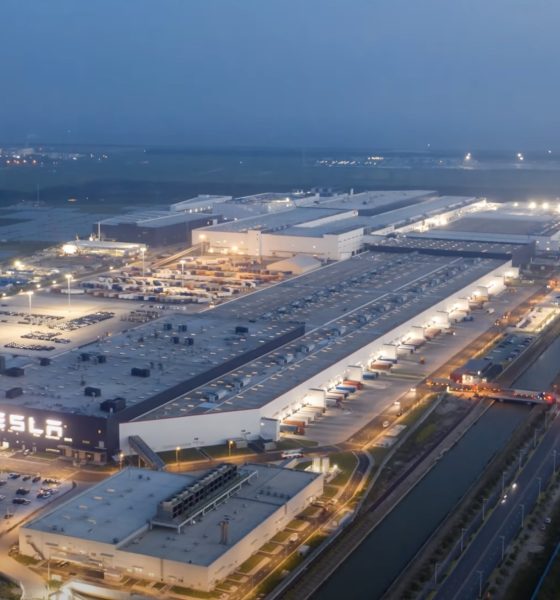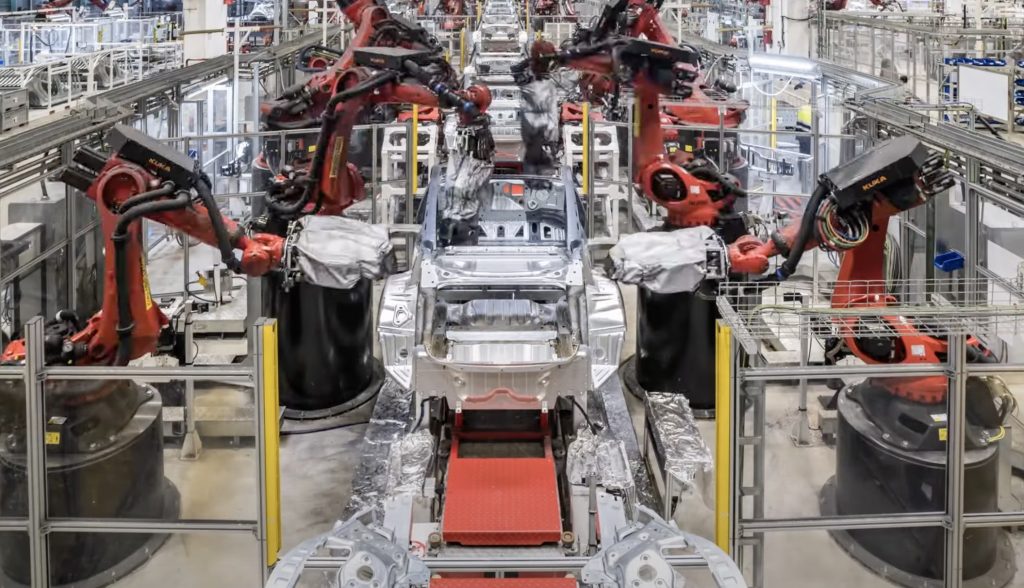

News
Tesla China gives sneak peek at Giga Shanghai operations with new video series
Tesla China announced that it would release a series of videos providing a sneak peek into Giga Shanghai’s operations. The first video in the series shares information about Tesla China’s cost management strategy.
Giga Shanghai’s Layout
The first factor in Tesla China’s cost control strategy is Giga Shanghai’s layout. The stamping, welding, painting, and assembly workshops are connected to minimize “the logistics path” between each process, improving efficiency. Giga Shanghai also utilizes the longitudinal space in all its workshops through elevators and machine transportation tracks. The placement of Giga Shanghai’s docks is also a way of running the factory efficiently, which minimizes time and costs.
Elon Musk once stated that Tesla’s gigafactories would become products themselves. Tesla China seems to have taken that to heart with Giga Shanghai.
“It can be said that the innovation of the factory itself builds [an] enforceable foundation for the innovation of the production and manufacturing. Without this foundation, cost control would be like a tree without roots or water without a source,” noted Tesla China.
Take a tour inside Tesla Gigafactory Shanghai and follow us to explore the unique charm of the "Tesla Giga Principle" of cost control.
A series of cool videos will be released later. Don't miss out👀 Let’s #GoGiga 🔥 @elonmusk
🔗https://t.co/7jdNmCipL8— Tesla Asia (@Tesla_Asia) December 16, 2021
Tesla China R&D Center
Tesla’s local R&D Center in Shanghai was completed earlier this year. Tesla China states that the R&D Center is another pillar in its cost management strategy. The R&D Center handles essential parts of Tesla’s manufacturing process from design to testing and quality control.
Tesla China believes the R&D Center provides a complete closed-loop product development process. It helps Giga Shanghai vehicles evolve over time by delivering precise cost management blueprints that improve the affordability of Tesla products, from its all-electric vehicles to its battery storage systems.
Tesla Giga Shanghai Production
Tesla Giga Shanghai’s production process is yet another factor contributing to lowered costs. The process includes independent parts production. An excellent example of independent parts production would be the Tesla Model 3 and Model Y’s single-cast rear bottom plate.
“Take the Model 3 as an example. It needs roughly more than 70 punch-welded parts for the rear bottom plate. Most OEMs usually outsource those parts production, and they still have to set up a welding line,” said one Tesla Chain Casting Process Engineer.
“So, the whole production cycle is quite long. After we realized the one-piece casting, we only need the aluminum ingots from a supplier to manufacture it ourselves, including melting, die-casting, post-treatment, and machining. Within a very short period of time, the raw materials will be molded into a complete rear bottom plate,” he said.

The management of the docks contributes to the efficiency of production as well. The factory handles nearly 2,000 containers a day. Each customer order affects the sequence the factory transports the car parts through the assembly line. Suppliers also follow customer orders by sending parts as each order is made.
Through this level of organization with suppliers and in Giga Shanghai, Tesla China ensures that little to no parts need to be kept in a warehouse. Giga Shanghai aims to have zero inventory.
The supply chain significantly affects production, as can be seen in the way the docks are managed. Localizing Giga Shanghai’s supply chain was crucial in Tesla China’s cost management strategy. The local supply chain helps reduce production costs and raise the standards for parts.
Tesla China’s cost control video provides a tiny glimpse into all the work and forethought that went into Giga Shanghai from layout to production. It also explains why Giga Shanghai has become cost-efficient and Tesla’s primary export hub.
Giga Shanghai has helped increase Tesla’s production and delivery numbers at a monumental level. In November, Tesla China’s Global VP Grace Tao stated that Giga Shanghai aims to produce 500,000 vehicles by the end of 2021.
Watch Tesla China’s Giga Shanghai feature in the video below.
https://youtu.be/esa7iC0MOJ8
The Teslarati team would appreciate hearing from you. If you have any tips, reach out to me at maria@teslarati.com or via Twitter @Writer_01001101.

Elon Musk
Elon Musk and Tesla AI Director share insights after empty driver seat Robotaxi rides
The executives’ unoccupied tests hint at the rapid progress of Tesla’s unsupervised Robotaxi efforts.

Tesla CEO Elon Musk and AI Director Ashok Elluswamy celebrated Christmas Eve by sharing personal experiences with Robotaxi vehicles that had no safety monitor or occupant in the driver’s seat. Musk described the system’s “perfect driving” around Austin, while Elluswamy posted video from the back seat, calling it “an amazing experience.”
The executives’ unoccupied tests hint at the rapid progress of Tesla’s unsupervised Robotaxi efforts.
Elon and Ashok’s firsthand Robotaxi insights
Prior to Musk and the Tesla AI Director’s posts, sightings of unmanned Teslas navigating public roads were widely shared on social media. One such vehicle was spotted in Austin, Texas, which Elon Musk acknowleged by stating that “Testing is underway with no occupants in the car.”
Based on his Christmas Eve post, Musk seemed to have tested an unmanned Tesla himself. “A Tesla with no safety monitor in the car and me sitting in the passenger seat took me all around Austin on Sunday with perfect driving,” Musk wrote in his post.
Elluswamy responded with a 2-minute video showing himself in the rear of an unmanned Tesla. The video featured the vehicle’s empty front seats, as well as its smooth handling through real-world traffic. He captioned his video with the words, “It’s an amazing experience!”
Towards Unsupervised operations
During an xAI Hackathon earlier this month, Elon Musk mentioned that Tesla owed be removing Safety Monitors from its Robotaxis in Austin in just three weeks. “Unsupervised is pretty much solved at this point. So there will be Tesla Robotaxis operating in Austin with no one in them. Not even anyone in the passenger seat in about three weeks,” he said. Musk echoed similar estimates at the 2025 Annual Shareholder Meeting and the Q3 2025 earnings call.
Considering the insights that were posted Musk and Elluswamy, it does appear that Tesla is working hard towards operating its Robotaxis with no safety monitors. This is quite impressive considering that the service was launched just earlier this year.
Elon Musk
Starlink passes 9 million active customers just weeks after hitting 8 million
The milestone highlights the accelerating growth of Starlink, which has now been adding over 20,000 new users per day.

SpaceX’s Starlink satellite internet service has continued its rapid global expansion, surpassing 9 million active customers just weeks after crossing the 8 million mark.
The milestone highlights the accelerating growth of Starlink, which has now been adding over 20,000 new users per day.
9 million customers
In a post on X, SpaceX stated that Starlink now serves over 9 million active users across 155 countries, territories, and markets. The company reached 8 million customers in early November, meaning it added roughly 1 million subscribers in under seven weeks, or about 21,275 new users on average per day.
“Starlink is connecting more than 9M active customers with high-speed internet across 155 countries, territories, and many other markets,” Starlink wrote in a post on its official X account. SpaceX President Gwynne Shotwell also celebrated the milestone on X. “A huge thank you to all of our customers and congrats to the Starlink team for such an incredible product,” she wrote.
That growth rate reflects both rising demand for broadband in underserved regions and Starlink’s expanding satellite constellation, which now includes more than 9,000 low-Earth-orbit satellites designed to deliver high-speed, low-latency internet worldwide.
Starlink’s momentum
Starlink’s momentum has been building up. SpaceX reported 4.6 million Starlink customers in December 2024, followed by 7 million by August 2025, and 8 million customers in November. Independent data also suggests Starlink usage is rising sharply, with Cloudflare reporting that global web traffic from Starlink users more than doubled in 2025, as noted in an Insider report.
Starlink’s momentum is increasingly tied to SpaceX’s broader financial outlook. Elon Musk has said the satellite network is “by far” the company’s largest revenue driver, and reports suggest SpaceX may be positioning itself for an initial public offering as soon as next year, with valuations estimated as high as $1.5 trillion. Musk has also suggested in the past that Starlink could have its own IPO in the future.
News
NVIDIA Director of Robotics: Tesla FSD v14 is the first AI to pass the “Physical Turing Test”
After testing FSD v14, Fan stated that his experience with FSD felt magical at first, but it soon started to feel like a routine.

NVIDIA Director of Robotics Jim Fan has praised Tesla’s Full Self-Driving (Supervised) v14 as the first AI to pass what he described as a “Physical Turing Test.”
After testing FSD v14, Fan stated that his experience with FSD felt magical at first, but it soon started to feel like a routine. And just like smartphones today, removing it now would “actively hurt.”
Jim Fan’s hands-on FSD v14 impressions
Fan, a leading researcher in embodied AI who is currently solving Physical AI at NVIDIA and spearheading the company’s Project GR00T initiative, noted that he actually was late to the Tesla game. He was, however, one of the first to try out FSD v14.
“I was very late to own a Tesla but among the earliest to try out FSD v14. It’s perhaps the first time I experience an AI that passes the Physical Turing Test: after a long day at work, you press a button, lay back, and couldn’t tell if a neural net or a human drove you home,” Fan wrote in a post on X.
Fan added: “Despite knowing exactly how robot learning works, I still find it magical watching the steering wheel turn by itself. First it feels surreal, next it becomes routine. Then, like the smartphone, taking it away actively hurts. This is how humanity gets rewired and glued to god-like technologies.”
The Physical Turing Test
The original Turing Test was conceived by Alan Turing in 1950, and it was aimed at determining if a machine could exhibit behavior that is equivalent to or indistinguishable from a human. By focusing on text-based conversations, the original Turing Test set a high bar for natural language processing and machine learning.
This test has been passed by today’s large language models. However, the capability to converse in a humanlike manner is a completely different challenge from performing real-world problem-solving or physical interactions. Thus, Fan introduced the Physical Turing Test, which challenges AI systems to demonstrate intelligence through physical actions.
Based on Fan’s comments, Tesla has demonstrated these intelligent physical actions with FSD v14. Elon Musk agreed with the NVIDIA executive, stating in a post on X that with FSD v14, “you can sense the sentience maturing.” Musk also praised Tesla AI, calling it the best “real-world AI” today.








